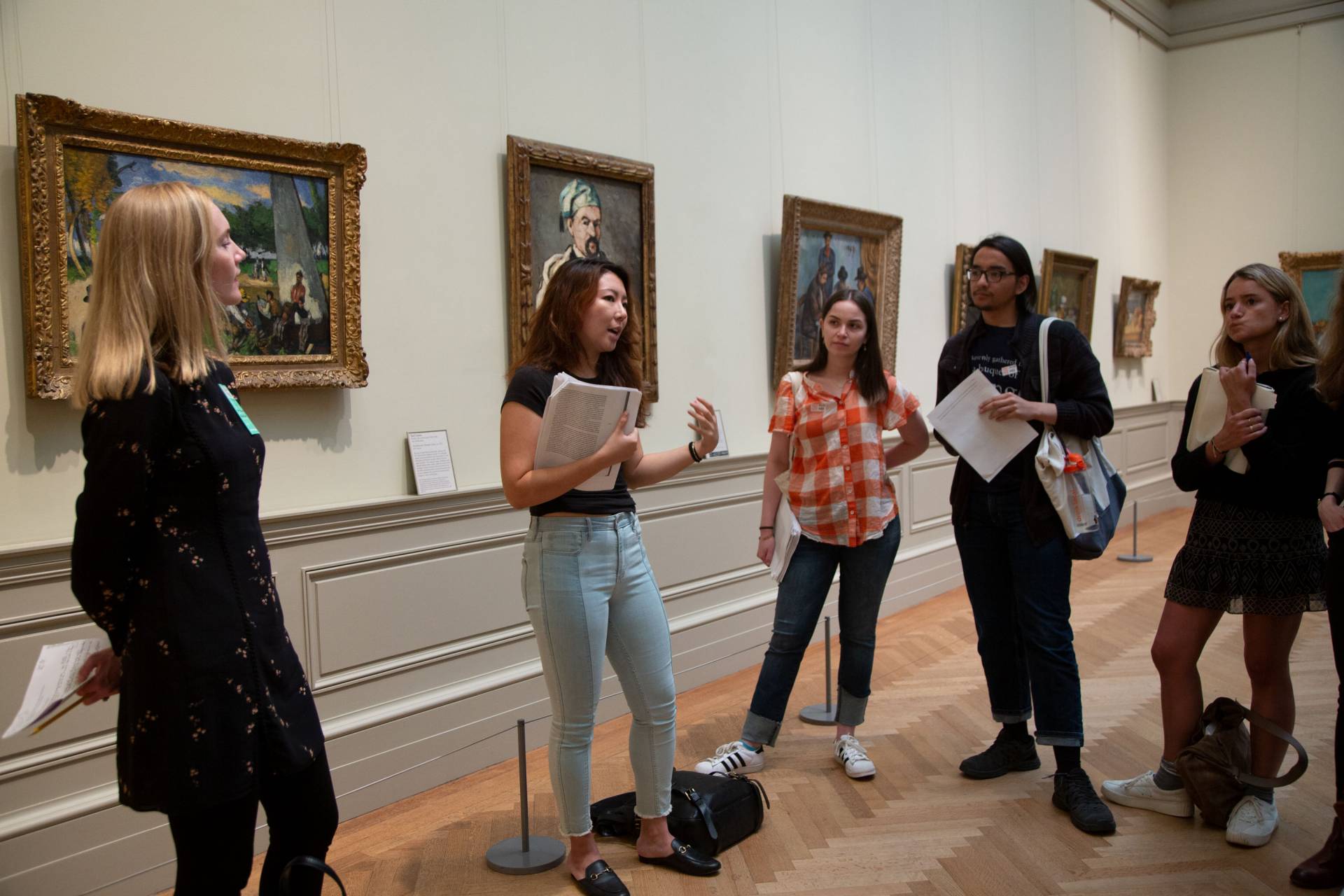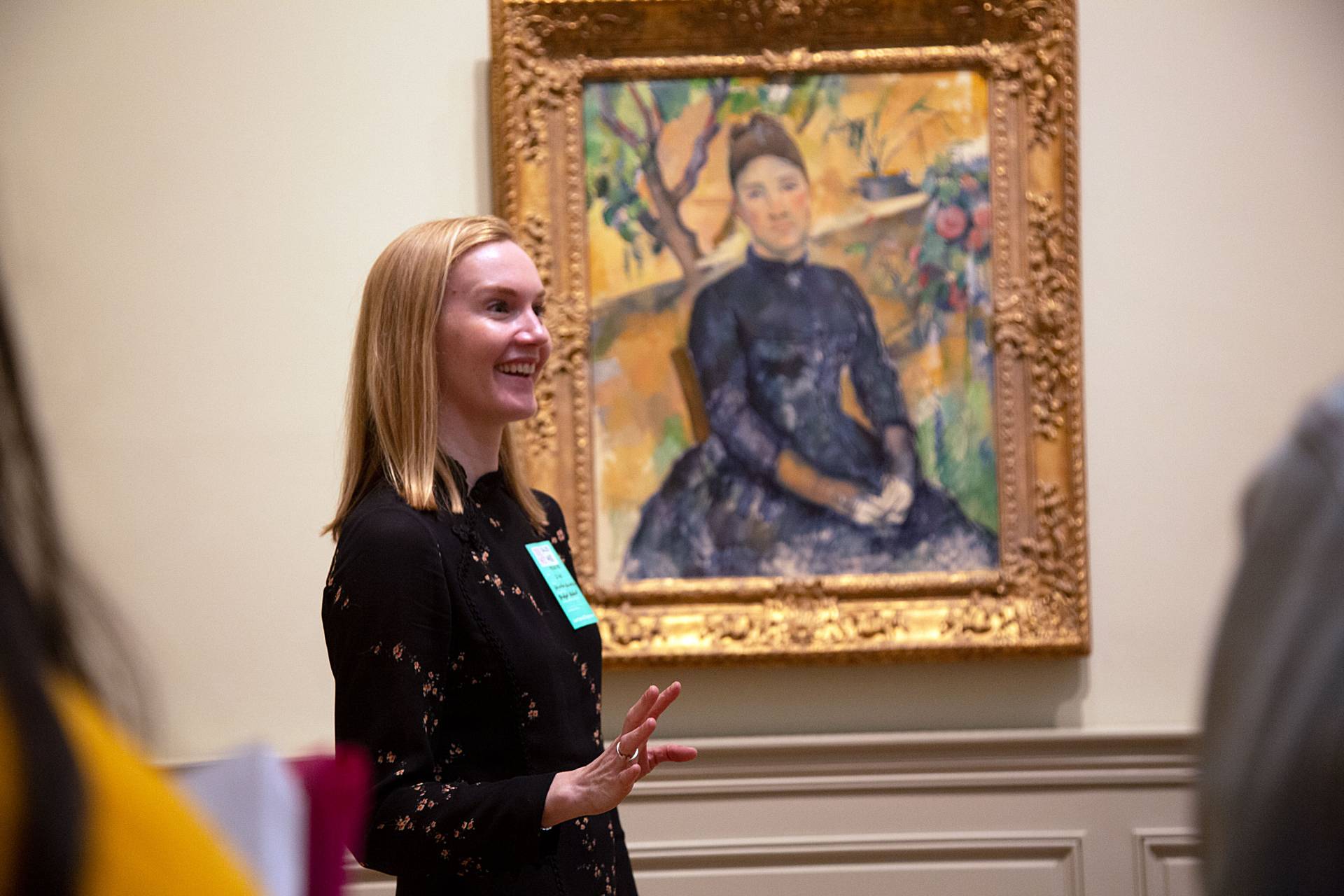In the spring course “Self and Society,” Bridget Alsdorf, associate professor of art and archaeology, shown at right, discusses work by Paul Cézanne at the Metropolitan Museum of Art in New York City.
What can molecular biology majors learn from Manet? Can Cézanne change the way English graduate students and undergraduate engineers approach their fields?
This year, Bridget Alsdorf, associate professor of art and archaeology, taught two courses on 19th-century French painting: “Painting and Literature in 19th-Century France and England,” co-taught with Deborah Nord, the Woodrow Wilson Professor of Literature, and “Self and Society in 19th-Century French Painting.”
While students in both courses examined paintings of the past, the courses’ interdisciplinary approach to art history helped students from a variety of academic backgrounds gain a better understanding of 19th-century art and its application to their lives today.

Senior SuMin Park gives a presentation on a Cézanne portrait.
'Painting and Literature'
Alsdorf, a specialist in 19th-century European art, has long been fascinated with the period’s French and Victorian novels. And while she wanted to teach a course that put the two in conversation, she also wanted a literature expert on board to do the material justice. “[Nord’s] deep knowledge of Victorian literature, coupled with her strong interest in visual art, made her an ideal collaborator,” said Alsdorf. “I was absolutely delighted when she said yes.”
Nord, who is working on a project about the relationship between 19th-century British fiction and visual arts, was equally enthused about the collaboration. “I have enjoyed co-teaching immensely over my 30 years at Princeton, and I very much admire [Alsdorf] as a scholar and colleague; I knew that I would learn a tremendous amount from teaching with her.”
In the fall 2018 graduate seminar “Painting and Literature,” students studied paintings inspired by literature and, inversely, painters and paintings as protagonists in novels and short stories.
For Nord, the 19th-century novel in particular lends itself to this kind of interdisciplinary study: “[The novel] encompasses the whole world of our experience as social and psychological beings. We find there: scientific thought, the family, class conflict, political revolution, the challenges of new technology, romantic love, discrimination and prejudice of all kinds, and on and on.”
Added Nord, “It is possible to read, enjoy and interpret novels without thinking in any depth about many of these things, but in my experience it enhances our understanding of the great achievement of the 19th-century novel to think about it from these different perspectives and, to some degree, through the lens of other disciplines.”
Alsdorf maintains a similar view of art history: “Art history is interdisciplinary by nature, because art intersects with so many aspects of culture and the natural world — politics, social history, science, literature, theater, philosophy, economics, the environment, and more. These intersections present themselves not only in an artwork’s subject matter and form, but also in its life in the world.”
This past May, Alsdorf received a Graduate Mentoring Award in recognition of her work in nurturing the intellectual, professional and personal growth of graduate students.

Deborah Nord, right, the Woodrow Wilson Professor of Literature, discusses the relationship between Edgar Degas’ painting “Interior” and Thomas Hardy’s novel “Tess of the D’Urbervilles” at the Philadelphia Museum of Art.
'Self and Society'
The paintings’ lives in the world — and their many intersections — was a core theme in Alsdorf’s spring 2019 “Self and Society in 19th-Century French Painting” course, which investigated how the rise of modern individualism manifested itself in French painting while also attending to the ways artists resisted isolation and narcissism in their work.
Many of these themes, as Alsdorf noted, are remarkably similar to the social and philosophical problems we are confronted with today, in the image-society of social media.
Annie Xie, a junior majoring in operations research and financial engineering, said: “I didn’t expect the class to have so many relevant ties to today. The same questions that these painters were grappling with — questions about the relationship between themselves and their colleagues, communities and the world — are ones we also try to solve. The topic of posing and constructing a filtered image of oneself is especially applicable to the prevalence of social media.”
The relevance of these themes is perhaps one reason “Self and Society,” a course cross-listed in art and archeology and French, appealed to students across a range of majors.
“I took [Self and Society] because it sounded interesting and a little outside of my comfort zone,” said Xie. “I wasn’t the only student from a STEM background, and Professor Alsdorf was very supportive of that; our seminar was filled with interesting and engaging discussions from a variety of viewpoints.”
These discussions helped Julia Casazza, a senior majoring in molecular biology, come away with a newfound appreciation for art history. “Coming from a STEM background, I found [the course] challenging but also really exciting. As a biology student, I am trained to look at data and think critically about it; art history requires the same sort of attention to detail, but it’s far more difficult to substantiate any claim you make.”
She added: “Many of our readings drew from knowledge of gender studies, sociology and literature as part of their arguments, which I enjoyed. [The course] helped me see how rich art history is as a discipline.”

Alsdorf enjoys the engaging conversation around Cézanne's portrait “Madame Cézanne in the Conservatory.”
A tale of two cities
Both courses took advantage of Princeton’s proximity to New York and Philadelphia with excursions to the Metropolitan Museum of Art and the Philadelphia Museum of Art, where students could see some of the paintings they read about and discussed in class.
“There is no comparison between digital images, however high-resolution, and original artworks,” said Alsdorf. “The real thing — its color, texture, scale and material presence — has an electric effect on group discussion, and we always discover details in person that we wouldn’t have noticed or appreciated on a screen.”
Many students, like Andrew Finn, a graduate student in the Department of English, were struck by the sheer size of some paintings. “Words and pictures in books cannot do [Eugène Delacroix’s paintings] justice,” he said.
“Without standing in front of the paintings, it is difficult to get a sense of their size or what they do to viewers; some paintings are massive in real life!” said Akrish Adhikari, a graduate student in the Department of French and Italian. “This can fundamentally alter how we study a painting.”
Others, like Jenna Liuzzi, a graduate student in the Department of French and Italian, appreciated some of the less-tangible aspects of seeing a painting in real life: “Seeing a painting live — in front of you — adds a sense of concreteness in that you’re able to discuss and analyze a tangible document — a document that was touched by the artist themselves. In this way, one feels more connected to the work.”
According to Alsdorf, another advantage of seeing art in museums is that the setting inspires discussion. “The students are so energized and focused when they’re in front of the objects … the atmosphere of respect and discovery that an artwork’s presence can foster is pretty extraordinary,” said Alsdorf.
“Until taking this seminar, I didn’t fully understand the value of seeing art in person, rather than only through a digital image,” said Xie. “Going to the Met helped deepen the insights and discussions we had in class; we were able to see details of paintings that we hadn’t seen before and experience the paintings in a different way.”






